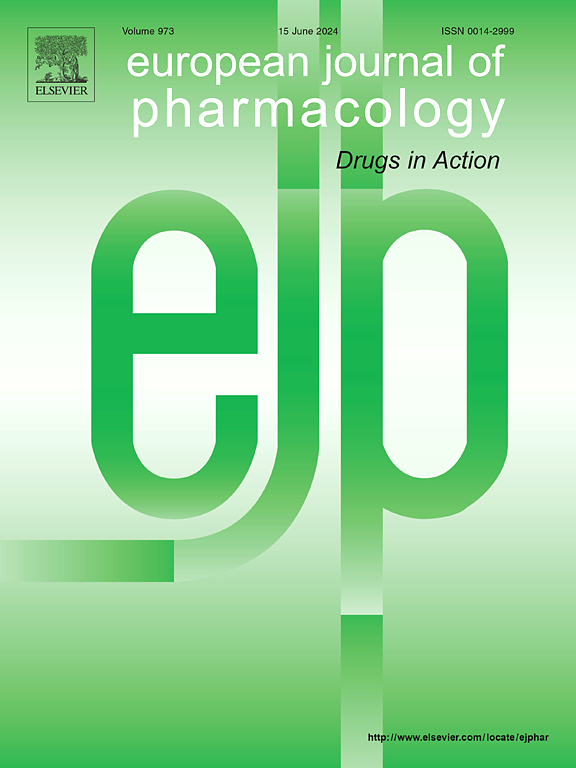Regulation of hippocampal miRNA expression by intestinal flora in anxiety-like mice
IF 4.7
3区 医学
Q1 PHARMACOLOGY & PHARMACY
引用次数: 0
Abstract
This study investigated the possible interaction between gut flora and miRNAs and the effect of both on anxiety disorders. The model group was induced with chronic restraint stress (CRS) and each group was tested for anxiety-like behaviour by open field test and elevated plus maze test. Meanwhile, the gut flora was analysed by 16S rRNA high-throughput sequencing. The miRNAs in hippocampus were analysed by high-throughput sequencing, and the key miRNAs were obtained by using the method of bioinformatics analysis. PCR was used to verify the significantly related key miRNAs. Spearman correlation analysis was used to explore the correlation between behaviour, key miRNAs and differential gut microbiota. The 16S rRNA high-throughput sequencing result showed that the gut flora was dysregulated in the model group. In particular, Verrucomicrobia, Akkermansia, Anaerostipes, Ralstonia, Burkholderia and Anaeroplasma were correlated with behaviour. The results of miRNA high-throughput sequencing analysis and bioinformatics analysis showed that 7 key miRNAs influenced the pathogenesis of anxiety, and qRT-PCR results were consistent with the high-throughput sequencing results. Mmu-miR-543-3p and mmu-miR-26a-5p were positively correlated with Verrucomicrobia, Akkermansia and Anaerostipes. Therefore, we infer that chronic stress caused the decrease of Akkermansia abundance, which may aggravate the decrease of mmu-miR-543-3p and mmu-miR-26a-5p expression, leading to the increase of SLC1A2 expression. In conclusion, gut flora has played an important influence on anxiety with changes in miRNAs.
肠道菌群对焦虑样小鼠海马 miRNA 表达的调控
本研究探讨了肠道菌群与 miRNA 之间可能存在的相互作用,以及两者对焦虑症的影响。研究采用慢性束缚应激(CRS)诱导模型组,并通过开阔地试验和高架加迷宫试验测试各组的焦虑样行为。同时,通过 16S rRNA 高通量测序分析了肠道菌群。通过高通量测序分析海马中的 miRNAs,并利用生物信息学分析方法获得关键 miRNAs。利用 PCR 验证明显相关的关键 miRNA。斯皮尔曼相关分析用于探讨行为、关键 miRNA 与肠道微生物群差异之间的相关性。16S rRNA 高通量测序结果显示,模型组的肠道菌群失调。其中,Verrucomicrobia、Akkermansia、Anaerostipes、Ralstonia、Burkholderia和Anaeroplasma与行为相关。miRNA高通量测序分析和生物信息学分析结果显示,7个关键miRNA影响焦虑症的发病机制,qRT-PCR结果与高通量测序结果一致。Mmu-miR-543-3p和mmu-miR-26a-5p与Verrucomicrobia、Akkermansia和Anaerostipes呈正相关。因此,我们推断慢性应激会导致Akkermansia数量的减少,这可能会加剧mmu-miR-543-3p和mmu-miR-26a-5p表达的减少,从而导致SLC1A2表达的增加。总之,肠道菌群与 miRNAs 的变化对焦虑有重要影响。
本文章由计算机程序翻译,如有差异,请以英文原文为准。
求助全文
约1分钟内获得全文
求助全文
来源期刊
CiteScore
9.00
自引率
0.00%
发文量
572
审稿时长
34 days
期刊介绍:
The European Journal of Pharmacology publishes research papers covering all aspects of experimental pharmacology with focus on the mechanism of action of structurally identified compounds affecting biological systems.
The scope includes:
Behavioural pharmacology
Neuropharmacology and analgesia
Cardiovascular pharmacology
Pulmonary, gastrointestinal and urogenital pharmacology
Endocrine pharmacology
Immunopharmacology and inflammation
Molecular and cellular pharmacology
Regenerative pharmacology
Biologicals and biotherapeutics
Translational pharmacology
Nutriceutical pharmacology.

 求助内容:
求助内容: 应助结果提醒方式:
应助结果提醒方式:


